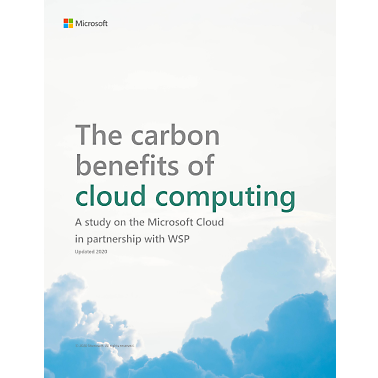Azure sustainability
Help build a clean-energy future and make progress toward your sustainability and business goals.
Sustainable cloud infrastructure with a local impact
At Azure, we see sustainability and humanity's response to climate change as one of the greatest challenges of our lifetime.
We believe it's not too late to plan for a cleaner, greener future. We've committed to put sustainable technologies at the heart of our innovation—to make sure we are adapting and growing along with the planet with the lowest environmental impact.
Learn how you can join the global community committed to reducing energy use, transitioning to a more carbon-neutral grid, and promoting a greener future with sustainable and innovative technologies from Azure.

The Carbon Benefits of Cloud Computing
A 2018 study found that using the Microsoft Azure cloud platform can be up to 93 percent more energy efficient and up to 98 percent more carbon efficient than on-premises solutions.
Evolving beyond an operational approach
Sustainability is often viewed from an operational point of view, with the environmental mission treated as a cost center in the business, as a risk or compliance to be managed. But for Azure, datacenters and sustainable cloud infrastructure are more than just business—they provide an incredible opportunity to give back to the communities where we operate.
Azure has committed to focus on four key areas of environmental impact to local communities—carbon, water, waste, and ecosystems.
100%
renewable energy by 2025.
Water positive by 2030
replenish more water than we consume by 2030.
Zero-waste
certification by 2030.
Net-zero
deforestation from new construction.
Giving back to local communities
With sustainability at the core of Microsoft’s business, we’ve extended our goals for environmental sustainability beyond just how we operate datacenters. We’re actively engaged in over 40 projects around the world to help make a local impact and improve environmental outcomes.
Here are some examples:

Optimizing water use
Using smart water meters to help mitigate a water crisis in South Africa regional hospitals.

Reforestation
Greening communities with native woodlands in Ireland.

Improving communal water quality and availability
Restoring natural habitats for beavers in central Washington state.

Urban area forestry
Planting trees and promoting stewardship in Des Moines, Iowa.

Promoting energy efficiency
Community engagement project to improve energy efficiency and energy savings at Irish college.

Partnering with renewable energy projects
Preparing skilled workers to take advantage of solar jobs at colleges in the state of Virginia.
Exploring energy innovations for the next generation of sustainable cloud technology

Learn how new server cooling methods can help minimize the environmental impact of physical datacenters—reducing energy use while providing higher processing power and helping to eliminate water consumption.

Find out how small steps like implementing grid-interactive UPS batteries—together with adding capacity and reducing the demand on the grid—can make a big difference to help us meet our sustainability goals and reduce our carbon footprint.

See how a switch from traditional diesel to less-carbon-intensive fuels to run datacenter backup generators helps to reach net-zero carbon emissions.
Frequently asked questions
-
Renewable energy is energy that is collected from renewable resources, which are naturally replenished on a human time scale—such as solar energy, wind power, hydroelectric power, geothermal energy, tidal power, and biofuels. By 2025, Azure will shift to 100 percent supply of renewable energy, meaning that we will have power purchase agreements (PPA) for green energy contracted for 100 percent of carbon-emitting electricity consumed by all our datacenters, buildings, and campuses.
-
Azure, as a part of Microsoft, has been 100 percent carbon neutral since 2012. This means we are removing as much carbon each year as we emit, either by carbon removal (carbon offsetting) or reducing carbon emissions.
-
This means that by 2030, we want to remove more carbon each year than we emit. By 2050, our goal is to remove all of our historical carbon emitted—either directly or by electrical consumption—since Microsoft was founded in 1975.